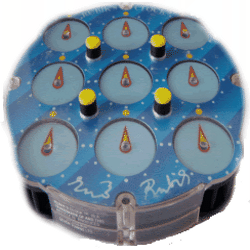Rubik's clock
 |
 |
The Rubik's clock is a two-sided puzzle having 9 dials on each side. Four pins which can be pushed up and down are placed between them. Rotary wheels are attached to the corner dials, and in dependence on the pins they are changing the position of the hour-hands in certain dials on puzzle's both sides at the same time. The goal is to set the hour-hands of all dials on both sides for 12 o'clock.
On this page you will find:
- Rubik's clock - solving of cross on one side
- Rubik's clock - solving of one side, setting of all hour-hands for 12 o'clock
- Rubik's clock - applying of 1st and 2nd step to the other side of the puzzle
- world record videos
Rubik's clock - solving of cross on one side
Each diagram below represents a position after finishing a given phase. What wheel has been rotated is depicted by a violet color. Yellow rings represent the pins being pushed up. When yellow ring is missing on the diagram, corresponding pin is being pushed down.
 |
From left to right we can see a gradual solving of cross consisting of five hour-hands of the dials. Fifth diagram sets all cross-hour-hands for 12 o'clock. Meaning of this phase is described below.
Rubik's clock - solving of one side, setting of all hour-hands for 12 o'clock
Solve the rest of the side in a way so that several hour-hands would always move to one of them, not in a way so that one hour-hand would move to several of them. After completing one side and setting of all hour-hands for 12 o'clock, turn the puzzle over (preferably from right to left or vice versa, not from top to bottom or from bottom to top).
 |
Rubik's clock - applying of 1st and 2nd step to the other side of the puzzle
Just apply both previous steps (in their correct order) to the other side of the puzzle.
TIP: The solution can be shortened when we set cross-hour-hands for 12 o'clock in the first step and instead of solving the rest of the side (see the second step) continue by turning the puzzle over and solve the other side in a classical manner - cross at first, then the rest.
World record videos
As a football has FIFA and athletics has IAAF, also the Rubik's clock has some sort of board that organizes the competitions worldwide. It is WCA - World Cube Association. Thus it can be officially competed in a solving of the Rubik's clock. It is competed in two formats: single fastest solve of the puzzle and average solve. As an average, five consecutive times of one round are taken, the best and the worst time is not considered and from the remaining three times an arithmetic mean is calculated.
| event: Rubik's clock single solve | ||
| name: Yunhao Lou (China) | ||
| result: 2.87 s | ||
| scramble: available upon request | ||
| solution: available upon request | ||
| puzzle brand: QiYi MoFangGe M | ||
| solving method: Pochmann's | ||
| personal opinion on used method: see below | ||
| competition: Guangdong Open; 1-3. 5. 2021; China |
| event: Rubik's clock average solve | ||
| name: Yunhao Lou (China) | ||
| result: 3.86 s | ||
| scrambles: available upon request | ||
| solutions: available upon request | ||
| puzzle brand: QiYi MoFangGe M | ||
| solving method: Pochmann's | ||
| personal opinion on used method: see below | ||
| competition: Guangzhou Good Afternoon; 13. 12. 2020; China |
If you find a so-called speedsolving interesting, check out an article about where to buy a Rubik's clock, what brand is the best and how to solve it faster.
Personal opinion on methods used in the world records
Rubik's clock:
Since I don't solve the Rubik's clock very often, I wasn't sure if there is any other speed method than Pochmann's one (its basis is de facto shown above), and if a puzzle from a manufacturer other than Rubik is available on the market. Former world record holder, Sam Zhixiao Wang, answered me in 2011: "There are other methods but they are similar to each other. The clock I use is Rubik's brand. There are some Chinese brands but they all suck."